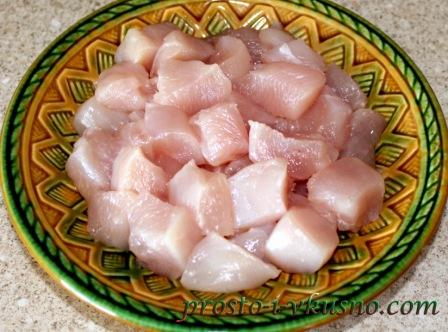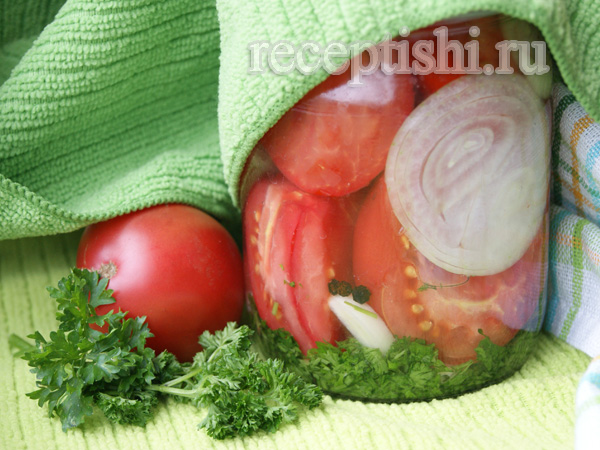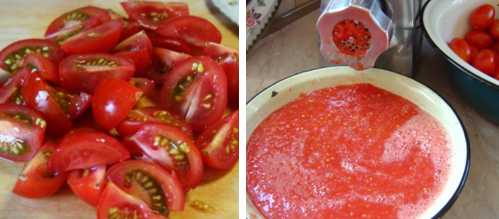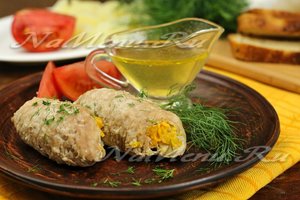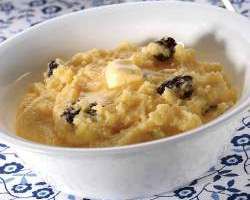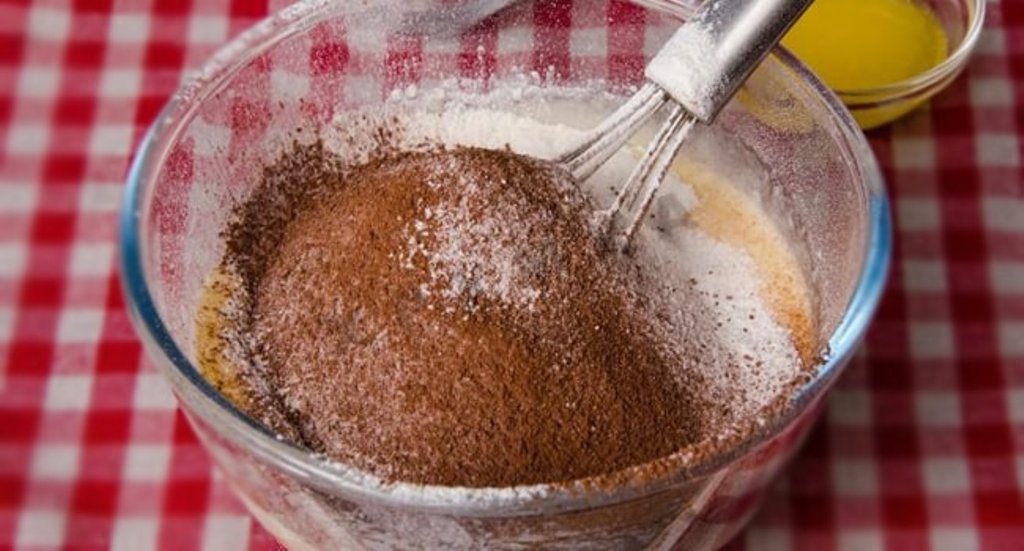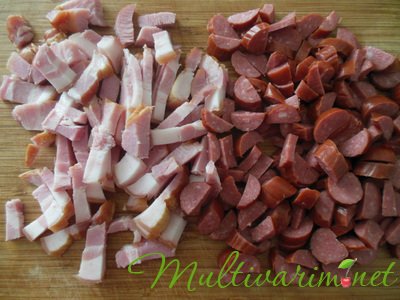Ajapsandal or Ajapsandali: a Caucasian vegetable dish. Georgian recipe ajapsandal (adjab sandalwood)
Ajapsandal for eastern peoples is like dumplings for Russians, borsch for Ukrainians, pasta for Italians, onion soup for the French or pudding for the British. Perhaps the comparison is not entirely successful, but the essence is not difficult to grasp. Although the set of ingredients from which Ajapsandal is prepared is almost the same everywhere, every Georgian, Abkhazian, Azerbaijani or Armenian adds something of its own to juicy vegetable caviar. Therefore, the dish turns out with a twist, peppercorn, cherry on the cake ... In general, call it what you want. The meaning will remain the same. For example, I cook this dish, as described in the photo recipe below. And although I do not have the slightest, even the most distant relation to the peoples of the East, I offer my interpretation of the famous snack. Because it turns out really tasty. So much so that you want to eat right with a spoon.
Ajapsandal is prepared from the following ingredients:
How to prepare ajapsandal (step by step recipe with photos):
|
Let's start cooking summer flavored ajapsanldal? Wash vegetables thoroughly. Get wet from moisture. Wrap eggplant, peppers, zucchini and tomatoes with aluminum foil with the shiny side facing out. Preheat the oven to 180-200 degrees. Transfer prepared vegetables to the rack or baking tray. Take out the baked ingredients as you cook. After 10-15 minutes, large tomatoes will be ready. After 5 minutes, the pepper will be ready. Immediately check if the aubergines are baked by putting on a potholder. They should be soft to the touch. The zucchini is cooked the longest. In the oven, he should spend about 20-25 minutes. On a note. Cooking in the oven can be replaced by roasting. The haze snack is even tastier. |
|
|
Cool the baked vegetables. Carefully remove foil from them. Clean. It’s easy to do it even with your hands; the peel almost completely disappears. |
 |
|
Is it comfortable to touch vegetables? Start cutting. I used to make ajapsandal from vegetables, diced into small cubes. As this photo recipe demonstrates. But no one will be offended if you cut into cubes. The first is pepper. Because he cooled off the fastest. But you can change the slicing sequence. |
 |
|
Eggplant. It is advisable to use young "little blue ones" so as not to bitter. And large grains in a dish do not look very appetizing. |
 |
|
Tomatoes But baked tomatoes cut into a cube does not work. The soft flesh “spreads out” even under a sharp knife. Well, okay. It will be a light tomato dressing with which ajapsandal will be even juicier and tastier. |
 |
|
From the baked zucchini remained. The peel is not removed from it as easily as from other vegetables. Have to work with a knife. Zucchini pulp also cut into cubes. If there are large seeds, discard them. |
 |
|
Now spices. Take 3-4 medium cloves of garlic. Peel and chop finely and finely. |
 |
|
Cilantro and basil. This aromatic splendor can be replaced with parsley. Or use only cilantro. Wash selected greens. Dry it. Finely chop. |
 |
|
Then the highlight. Rather, peppercorn. Do not like spicy? Will the children eat the dish? Do not put hot pepper. In my photo recipe it is. Have you decided to add? Cut the right amount from the pod. Take out the seeds. Finely chop finely. Wash hands, knife and chopping board thoroughly. |
 |
|
Put the ingredients in a large bowl. Add salt and ground pepper. Pour in vegetable oil if desired. If you do not consider it superfluous. |
 |
|
Stir and serve the appetizer. To a barbecue or just a juicy ruddy piece of meat. To the fish. Or just lay it on the bread. Only more! |
 |
The most pleasant, fragrant and oriental appetite!
How to make ajapsandal with meat? For reference: Ajapsandali or Ajapsandal dish of Caucasian cuisine (Georgian, Armenian, Abkhaz etc.). Ajapsandal in translation means "how wonderful you are." Ajapsandali is prepared from the required ingredients: eggplant, tomatoes, bell peppers, onions, garlic, a bunch of cilantro, basil, vegetable oil and salt, pepper to taste. Sometimes potatoes and hot peppers are added, and ajapsandal can also be prepared with meat. What are we going to do now.
Tasty Caucasian dish - ajapsandal with meat. Please note that for the preparation of ajapsandali with meat, pork can be replaced with veal or beef.
Ajapsandal with meat recipe
5 from 1 reviews
Ajapsandal with meat
Type of dish: Meat dishes
Cuisine: Georgian
Output: 5
Ingredients
- Pork pulp - 250 g,
- onions - 2 heads,
- carrots - 1 pc.,
- eggplant - 2 pcs.,
- sweet pepper - 3 pcs.,
- potatoes - 4 pcs.,
- 3-4 tomatoes - pcs.,
- parsley greens - a bunch,
- garlic - 2 cloves,
- butter 50 g,
- vegetable oil - 2 tbsp. l.,
- ground black pepper,
- salt.
Cooking
- Rinse the pork meat with a paper towel, and then cut into small pieces and fry in a preheated pan with sunflower oil until a golden crust forms.
- Onions cut into half rings, and carrots into cubes.
- Next, add the carrots and onions to the meat and fry, stirring, for another 5-7 minutes.
- Then, cut the peel from the eggplant, and cut the sweet pepper in half along, remove the seeds.
- Cut eggplant, bell peppers and potatoes into cubes.
- Finely chop the tomatoes and herbs. Chop the garlic.
- On pieces of meat fried with onions and carrots, lay out pieces of cream (can be melted), then layers: potatoes, eggplant, bell peppers, tomatoes and greens, sprinkling layers with salt, pepper and garlic.
- Simmer ajapsandali for 40 minutes over low heat.
- When serving, put ajapsandali with meat on a beautiful dish and decorate with sprigs of greenery.
Enjoy your meal!
Ajapsandal with meatHow to cook ajapsandal with meat? For reference: Ajapsandali or Ajapsandal is a dish of Caucasian cuisine (Georgian, Armenian, Abkhaz, etc.). Ajapsandal means "how wonderful you are." Ajapsandali is prepared from the required ingredients: eggplant, tomatoes, bell peppers, onions, garlic, a bunch of cilantro, basil, vegetable oil and salt, pepper to taste. Sometimes potatoes and hot peppers are added, and ajapsandal can also be prepared with meat. What are we going to do now. Let's cook a delicious Caucasian dish - ajapsandal with meat. Please note that for the preparation of ajapsandali with meat, pork can be replaced with veal or beef. Ajapsandal with meat recipe 5 from 1 reviews Ajapsandal with meat ...
Ajapsandal is a dish of stewed vegetables, popular in several Caucasian countries. The authorship of this unique dish is disputed by Armenians, Georgians, Azerbaijanis, Abkhazians. It is already impossible to establish which of them it belongs to. However, one cannot fail to admit that each nation has brought something of its own to the recipe. Ajapsandal in Armenian has much in common with ajapsandal in Georgian or Azerbaijani, but at the same time differs from them. For example, the Armenians choose their own set of spices and spices for this dish, often include potatoes or carrots, prepare ajapsandal so thin that it resembles soup in some ways, although it is actually the second dish. Armenian ajapsandal is tasty, fragrant and very useful, as it is prepared from juicy and ripe vegetables, rich in all kinds of vitamins.
Cooking features
Ajapsandal itself is prepared according to certain rules, which are not even dependent on the recipe. However, the technology for preparing ajapsandal in Armenian has its own characteristics. If you want to cook this dish of Armenian cuisine, you need to be guided by a number of rules, then the finished dish will be identical in taste and appearance to the traditional one.
- Eggplants are an indispensable ingredient without which ajapsandal immediately turns into vegetable stew. These vegetables need preliminary preparation, otherwise they will retain solanine, which will give the dish an unpleasant bitter taste. In order to get rid of solanine, eggplant is soaked for 20-30 minutes in brine, for the preparation of which 10 g of salt is added to each liter of water. You can just add the eggplant and then rinse. Rinse vegetables must be, otherwise they will be salted and spoil the taste of the whole dish.
- The second essential ingredient of Ajapsandal in Armenian is sweet pepper. Preference is given to those varieties that are green. They may not look so beautiful in a finished dish, but they have a more intense taste.
- Armenian ajapsandal often includes potatoes. Its cooking time is slightly longer than other vegetables. For this reason, it is preliminarily recommended to lightly fry it, and then lay it in the dish.
- Vegetables for ajapsandal can not be fried, in which case it will be dietary. However, more often they are still fried before stewing. Due to this, they acquire other flavoring notes and better retain their shape when extinguished.
- If you are preparing ajapsandal in Armenian, use butter to fry vegetables. Using vegetable oil instead of butter is possible, but in this case, the taste of the dish will be less delicate than that of traditional Armenian Ajapsandal.
- Ajapsandal is prepared in dishes with a thick bottom and thick walls. Thanks to this, the vegetables are saturated with juices and aromas of each other and the spices that make up the composition, so that the dish turns out to be very tasty.
- Traditional Armenian ajapsandal is prepared from vegetables alone, but ajapsandal with meat is also considered a classic. The main thing is that there is not too much meat in it, it is vegetables that should dominate.
Ajapsandal is served both as a side dish for meat and as an independent dish. He is satisfying enough not to need any supplement.
Armenian ajapsandal with carrots
- eggplant - 0.5 kg;
- sweet pepper - 0.5 kg;
- carrots - 0.5 kg;
- onions - 100 g;
- garlic - 4 cloves;
- cayenne pepper - 1 pc.;
- fresh cilantro - 20 g;
- fresh parsley - 20 g;
- fresh basil - 20 g;
- butter - 150 g;
- tomatoes - 1 kg;
- salt, hops-suneli - to taste.
Cooking method:
- Wash the eggplants and cut them in half lengthwise without removing the tails. Cut each half along, just a couple of centimeters or even less before reaching the tails. Salt and leave for 15 minutes. After the indicated time, rinse well in running water and pat dry with paper towels.
- Put half the butter in a pan, set it on a fire. When the butter melts, fry the eggplants on all sides, not separating the oblong pieces from the base.
- Peel the carrots and cut them into strips or thin cubes.
- Remove the peel from the onion, cut it into thin quarters of rings.
- Finely chop the garlic.
- Wash the peppers, cut off their stalks. Each pepper is cut lengthwise into 4 parts. Cut into quarters of rings about 3-4 mm thick.
- In the pan where the eggplant was fried, add the remaining oil.
- In the melted butter, put onions and carrots, fry them for 10 minutes. Add pepper and garlic, continue frying for another 5 minutes.
- Hot pepper cut into small rings. Remove the seeds from them, so they have an overly burning taste.
- Put in a cauldron a mixture of onions, carrots, peppers and garlic, adding to it rings of hot pepper. If the pan is deep, you can not shift the vegetables, but put them out in it.
- Slice washed tomatoes, spread them on top. Salt and season the dish.
- Cover all with strips of eggplant, cutting them off the base.
- Cover the pan or cauldron with a lid, put on low heat. Stew ajapsandal for about half an hour.
Before you lay out ajapsandal on plates, it must be mixed and sprinkled with chopped herbs.
Ajapsandal prepared according to this recipe has a sharp taste. If you are not a lover of hot dishes, you can choose another Ajapsandal recipe in Armenian, which will have a milder taste, or exclude hot pepper from the recipe (the amount of garlic can be left unchanged).
Armenian ajapsandal with meat and potatoes
- lamb or pork - 1 kg;
- eggplant - 0.7 kg;
- tomatoes - 0.5 kg;
- sweet pepper - 0.7 kg;
- potatoes - 0.7 kg;
- onions - 0.25 kg;
- dried basil - 10 g;
- dried rosemary - 5 g;
- bay leaf - 3 pcs.;
- ghee - 50 g;
- salt, pepper - to taste;
- water - as needed.
Cooking method:
- Wash the meat, dry it with a kitchen towel, cut into medium-sized pieces (approximately two 2 cm).
- Wash and peel the eggplant. Cut them into large cubes, slightly smaller than pieces of meat.
- Dip the eggplant in salted water, dissolving in it before this salt in the ratio of 10 g of salt per 1 liter of water. Leave for half an hour, then rinse and let dry.
- Pour the tomatoes over boiling water and peel them. Peeling tomatoes will be even easier if you do not just pour them with hot water, but immerse them in boiling water for a couple of minutes, making a cross-shaped incision on the skin before it.
- Cut peeled tomatoes into circles.
- Peel the potatoes. Cut it into the same pieces as the eggplant.
- Wash the peppers. Cut off their areas with a stalk. Cut each pepper along and extract the seeds. Cut the pepper into half rings not too thin.
- Cut the peeled bulbs into thin halves of the rings.
- In a pan with a thick bottom, heat ghee. Sauté the onion in it until golden.
- Put the meat in a pan and fry it with onions until golden brown.
- Pour the meat with water so that it is completely covered with liquid. Wait until the water boils, add salt, spices, bay leaf and cook meat for 10 minutes.
- Dip the eggplant slices into the pan, after 5 minutes send the potatoes there and wait another 5 minutes. Lay pepper, cover everything with tomato mugs.
- Stew vegetables with meat in the broth for 40 minutes. Cover the pan for this time with a lid, make the fire small.
When serving, it is advisable to add chopped greens to each plate. You can also add green beans to Ajapsandal. 200-300 g will be enough for the indicated amount of ingredients.
Ajapsandal in Armenian successfully replaces both the first and second dishes, which can saturate a person with excellent appetite.
Ajapsandali (ajapsandal, ajapsanda) is a Georgian, Armenian and Azerbaijani vegetable dish that resembles the familiar eggplant sauté. We will tell you how to prepare ajapsandal in several ways and the recipe for its preservation in this material, and so that you can do everything without any difficulties, we offer detailed descriptions of the cooking process with beautiful photos.
Adjapsandali in Georgian
The classic recipe is the foundation that can always be supplemented at your discretion. The main rule that must be observed in the manufacture of ajapsandali in Georgian: do not turn vegetables into porridge, since then it will be a completely different dish.

The list of necessary products per 1 kg of eggplant:
- ripe juicy tomatoes - 0.5 kg;
- onions - 350 g;
- sweet pepper - 0.5 kg;
- chili - 1 pod;
- fresh basil, cilantro, parsley - a handful;
- garlic - 1 head;
- Flavourless Olein for frying - 300 ml;
- salt, freshly ground black pepper.

Step-by-step instructions for cooking:
- Wash medium-sized eggplants, dry and cut into halves of rings. Put in a bowl, add, mix and leave for a while to make the glass bitterness.
- Pods of bell pepper get rid of the stalk and seeds, washed and cut into strips of a centimeter wide.
- We cut the tomatoes into cubes, and the onion into half rings, but not very wide. Garlic and Chile with tiny thin plates.
- Pour oil into a thick pan and heat it well. We squeeze blue ones from the allocated juice and fry in parts. They need to interfere as little as possible. It is best to lay them so that they completely cover the bottom. Frying them well on both sides, take them out on a plate.
- In the same pan, adding fat, fry the pepper, and then the onions.
- At the same time, we put out the tomatoes in another pan. Everything must be done under the lid so that the juice does not evaporate. At the end of cooking, add the plates of garlic and chilli, add and pepper, sprinkle with chopped fresh grass.
- Pour a little oil into the roasting pan and pour the fried vegetables. Gently mix them, pour the tomato mixture and let it boil lightly for no more than 10 minutes. Tasty and healthy Georgian dish is ready.
Classical Armenian Ajapsandal
The Armenian recipe is slightly different in its composition. It is also more fluid and resembles soup rather than stew. We suggest you make ajapsandal from Stalik Khankishiyev.

List of required ingredients:
- 1 kg of pork;
- 700 g of blue and bell pepper;
- hot pepper pod;
- 500 g tomato;
- peeled potatoes - 700 g;
- carrot - 300 g;
- onion - 300 g;
- garlic - half the head;
- dried herbs: basil, rosemary;
- lavrushka - 3 pcs.;
- ghee - 200 g;
- salt, pepper, water.
Description of the cooking process:
- We washed and dried blue ones into pieces, 3 centimeters wide. Mix with salt and leave for half an hour in order to make the glass bitterness.
- Peeled potatoes are cut in the same cubes as eggplant. Onions and peppers are cut into not very thin half rings, carrots - into cubes. Garlic and chili mode in small pieces.
- We cut the meat in pieces 2 cm wide.
- In a brazier or cauldron we drown part of the oil. Gold the onions and carrots. Add the pork and fry it until golden brown. Now add so much liquid that the meat is completely immersed. We wait when it boils, then add spices, add and let it boil for a short time.
- Now, every five minutes, we take turns putting blueberries, potatoes, and peppers.
- Grind with garlic and hot pepper. We remove the peel from the tomatoes, cut them into rings and spread them on top of our food.
- Reduce the temperature to a minimum, close the lid and simmer a little less than an hour. Pour the prepared ajapsandali with meat into plates and sprinkle with fresh chopped herbs.
Ajapsandali in the oven
In the modern kitchen, you can use household appliances to prepare such a tasty and healthy dish. So ajapsandal in the oven is obtained with a more saturated taste of vegetables.

To make ajapsandal in this way you will need:
- 4 eggplants;
- 4 tomatoes;
- 2 pods of sweet pepper;
- 2 onions;
- 1 kg of potatoes;
- ½ head of garlic;
- 100 g of spread;
- some water;
- salt pepper.

Instructions for cooking:
- Blue, as usual, you need to get rid of bitterness. Therefore, the mode is the same size pieces, add and leave for half an hour. The resulting dark liquid is drained.
- Potato tubers in sliced \u200b\u200bmode, pepper in thin strips, onion in half rings.
- We divide the tomatoes into slices, after washing and drying them.
- In a deep heat-resistant form, we melt the spread. Fry the onions until transparent, add the potatoes and fry for about 5 minutes. Pour the blue ones, gently mix the pepper, add, pepper and fry the same amount.
- Squeeze the garlic, put the tomato slices and pour in some water. We close the lid and put the stew for half an hour in the oven at 180 degrees.
- When the vegetables are ready, you can add fresh herbs to the roasting pan, cover for a little while. Then ajapsanda will have a pleasant spring aroma.
Ajapsandal at the stake on the grill
Vegetables made in this way are perfect for barbecue. And its usefulness is undeniable, since it is prepared without a single drop of fat. And so that everything will turn out right for you, we offer you a step-by-step recipe for ajapsandal made on the grill.

List of required products:
- blue ones - 3 pcs.;
- tomatoes - 4 pcs.;
- onion - 3 pcs.;
- sweet pepper - 3 pods;
- garlic - a few cloves;
- greens - to taste;
- vinegar, vegetable oil - a little.
Cooking Description:
- Ajapsandal on the grill is prepared quite simply. We wash all vegetables, get rid of husks, stalks and seeds. We string them on skewers (except garlic), which are laid out on a barbecue grill. Bake them until cooked.
- Hot tomatoes and eggplant need to be dipped for several minutes in cold water, peel them and cut into large pieces. We crumble the rest of the products there. Season with a few drops of oil and vinegar. We chop finely chopped garlic and herbs. If desired - can be added and crushed with ground black pepper.
Ajapsandali for the winter
Such yummy can be easily prepared for the winter. It turns out very tasty, slightly islandy.

To prepare it based on 2 half-liter jars, take:
- blue ones - 500 g;
- onion - 200 g;
- spicy pepper - 300 g;
- tomatoes - 200 g;
- garlic - 2 cloves;
- tomato paste - 2 tsp;
- Oleina - 100 ml;
- vinegar - 50 ml;
- water - 50 ml;
- salt - 1 teaspoon;
- sugar - 1.5 tbsp. spoons;
- freshly ground pepper - 0.5 tsp;
- hops-suneli - 3 pinches.

Detailed description:
- Since we will cook for storage in banks for the winter, the dishes must be thoroughly washed and sterilized.
- The washed eggplant is cut into halves of rings. We add and leave for half an hour, giving a drain of bitterness. Then fry them in a pan in a small amount of butter until half-cooked (about 10 minutes). Put in a saucepan.
- Fry the chopped onion until golden, add chopped tomatoes and a little water. Stew on low heat for about 5 minutes. Put in a saucepan.
- Dice the regimen in cubes, fry in a pan covered with a lid for about 10 minutes. Pour it into the rest of the products, add it, add spices, and chopped garlic.
- Mix well and set to stew for 15 minutes, sometimes mix so that the components do not burn. Add vinegar, wait a little bit and remove the fire.
- The spin in the jars is very hot. Wrap it overnight, and then store it as usual.
If you decide to cook an unusual vegetable dish, then the recipes of delicious Ajapsandali offered by us will come in handy. Thanks to them, your loved ones will be able to plunge into the atmosphere of real Caucasian cuisine and get a huge supply of vitamins.
Video: Vegetable Ajapsandali
Everyone is familiar with such dishes as barbecue, suluguni, ajapsandali, kebab and many, many others. All of them are united by a common origin - the Caucasus! Caucasian cuisine is a rather conventional concept, which always requires some clarification regarding a specific region. Most often, this term means the cuisine of Georgia, Armenia and Azerbaijan. May also imply the culinary traditions of the peoples of the North Caucasus and Dagestan.
Why, despite such uncertainty, continue to use this expression? The fact is that the culinary preferences of the peoples of the South Caucasus have much in common. Dishes are prepared from the same ingredients, and often give them very similar names. The same is true for the north of the region, but if you start to compare the cuisines of the north and south, the differences will be very significant. So you should always clarify which cuisine of the Caucasus is meant.
Culinary traditions of the South
It is very easy to highlight common denominators that combine Georgian, Armenian and Azerbaijani cuisines - these are meat, a variety of vegetables and herbs, a specific set of spices and, of course, red wine. Many dishes have long gained popularity outside the region, and in order to taste them you do not need to go to Tbilisi or Yerevan. Lobio, khachapuri, kebab - all this is familiar to people living in the post-Soviet space.
Meat dishes in the Caucasus are very common. They use a variety of meat (except for pork, which is not even common in Christian Armenia or Georgia) - lamb, beef, poultry. It is noteworthy that it is not customary to grind meat with a meat grinder here. Local chefs are able to finely chop meat with knives, and this is done in the cooking process. Stuffing is not accepted.
When the words “meat” and “Caucasus” are heard, the third word “barbecue” also certainly sounds. Indeed, this dish, simple at first glance, is the hallmark of the region. There are a great many recipes for preparing this dish, and each people considers it their national one, possessing their “secret” ingredients. At the same time, there is always a kebab where there is a large amount of vegetables and greens on the table.
Soups in the Caucasus are always very rich, thick and often contain ingredients that are very unusual for us. So, for example, Georgian kharcho soup, well known to us, is prepared in the original with the addition of walnuts. Piti soup is popular in Azerbaijan, where rich bone broth acts as the basis. Also one cannot fail to mention Kufta-Bozbash from Azerbaijan and Georgian hash. The first dish is a soup of peas and potatoes with meat balls, and the second is a broth of offal and lamb with spices.
Pilaf cannot be called a genuine Caucasian dish, nevertheless, it has also gained distribution here, although the recipe has undergone a number of changes. Some of these changes are so significant that many question the possibility of calling this dish pilaf. A common and most important change is that rice and meat are cooked separately. In addition, fish, vegetables and even berries are often used.
The mild and fairly warm climate of the region contributed to the fact that a large variety of greens appeared in the local cuisine. In total, the number of herbs and spices is approaching two dozen. Pomegranate juice, chopped walnuts, wine vinegar, as well as all kinds of sauces that deserve special mention are often served as seasonings. This is a very important part of the cuisine of the region and rarely what dish is served without sauces.
Some of them are real culinary masterpieces. For example, Georgian tkemali based on wild cherry plum or tomato satsibeli with the addition of saffron and cilantro. Continuing the conversation about the general features of the cuisine of the South Caucasus, one cannot but mention the fact that the vast majority of dishes are cooked on an open fire. Any products are subjected to such processing, which cannot but affect their taste.
Georgian dish Ajapsandali: how to cook
Concluding the conversation about the cuisine of the South Caucasus, as an example, the common culinary traditions of the peoples of the region, we can cite a recipe for one dish, the name of which does not differ much from different peoples. This is ajapsandali in Georgian - vegetable stew and one of the most popular dishes that are served with barbecue.
Ingredients:
- 2 eggplant;
- 0.5kg potatoes;
- 2 tomatoes;
- 1 sweet pepper;
- 1 onion;
- 3-4 cloves of garlic;
- 1 bunchokinza;
- 1 bunch of basilica;
- 2 tablespoons vegetable oil;
- 25 ml of water;
- salt, spices.
Cooking:
- Eggplant is cut into cubes, sprinkled with salt and left for half an hour. After that, they are washed and fried. We lay out the eggplants, and in the same pan we fry the carrots and bell peppers onion.
- Peeled tomatoes and garlic are finely chopped and sent to the pan. Add eggplant there. Leave to simmer for 1 minute.
- Finely chopped herbs and spices are added to the pan, and the dish is stewed for another 10 minutes.

After that, let Ajapsandali cool for 30 minutes and serve. By the way, local housewives in special ways make ajapsandali for the winter. Rolling the above vegetables in jars, and opening these blanks as necessary. There are many options for such a salad, or rather, there are as many as the hostesses, because each one brings something different to the recipe.
Cuisine of the North Caucasus
In general, the culinary traditions of this region have much in common with Transcaucasia. The mutual penetration of many dishes, as well as many borrowings from the Turkic peoples, is clearly visible. At the same time, the harsher climate and living conditions of the local peoples left their mark. This is noticeable in the variety of dishes and the ingenuity of the use of certain ingredients. In addition, in the north, dairy products play a more important role. So, for example, Ayran (sour-milk drink), cheeses, cottage cheese and of course kefir, which, unlike Ayran, is a primordially local invention, are very common here. All these products are well-known in Georgia and Armenia have always been present in large quantities in the diet.
The meat of animals (lamb, beef, poultry) was eaten fresh (mainly in summer and autumn, when cattle were slaughtered and on the occasion of an important event), dried and smoked. In this case, almost all parts of the carcass were used. So, for example, the characteristic dish is stuffed with crushed meat intestines, which are dried in the sun. In general, the use of entrails (ichi) is one of the hallmarks of local cuisine.
If you take fresh meat, then, unlike Armenia, it is usually fried here.

Cooking pies is very common, the recipes of which, given the multinational composition of the region, are great. At the same time, Ossetian recipes can be distinguished separately. They are prepared from yeast dough with a wide variety of fillings: potatoes, onions, cheese, pumpkin, cabbage, but primarily meat.
Of course, despite the large number of common features that are associated with the relatively compact residence of a large number of peoples, the North Caucasian cuisine is not homogeneous. Several main cuisines can be distinguished - Adyghe (Circassian), Ossetian, Ingush, Karachai. Each of them has its own unique dishes, even despite a limited selection of products.
